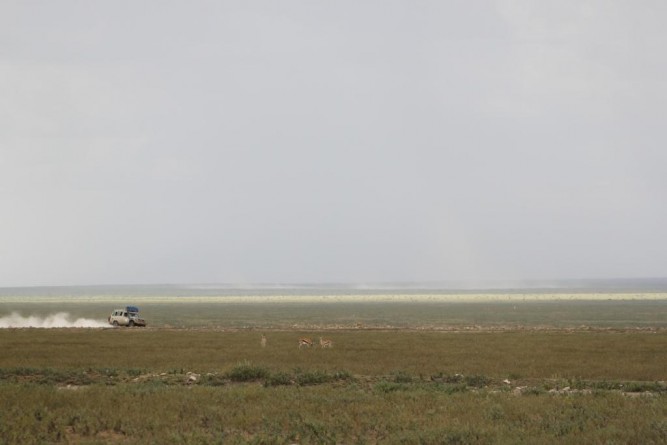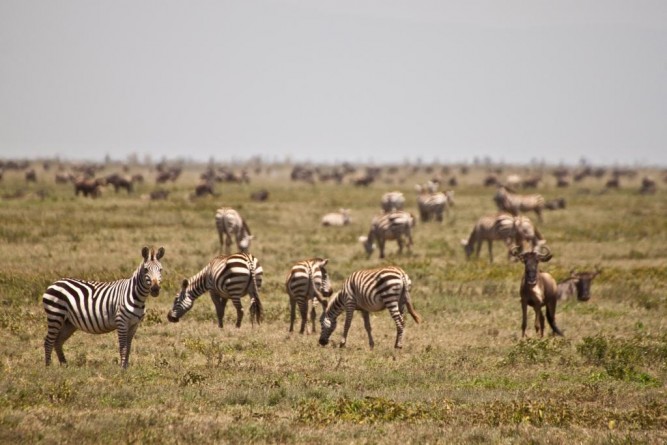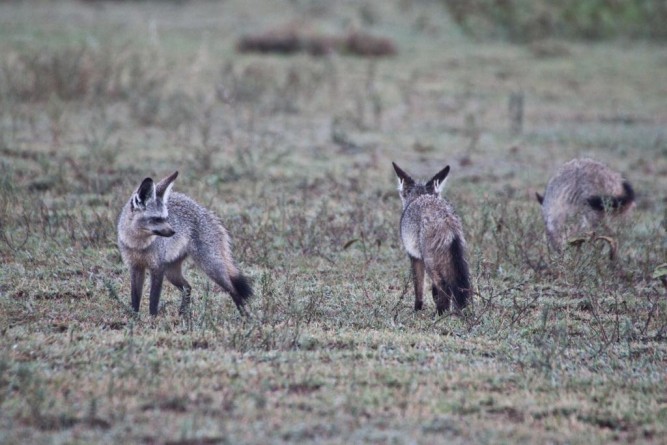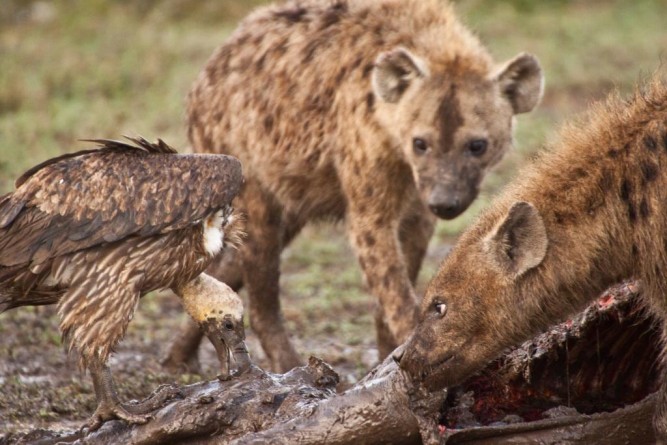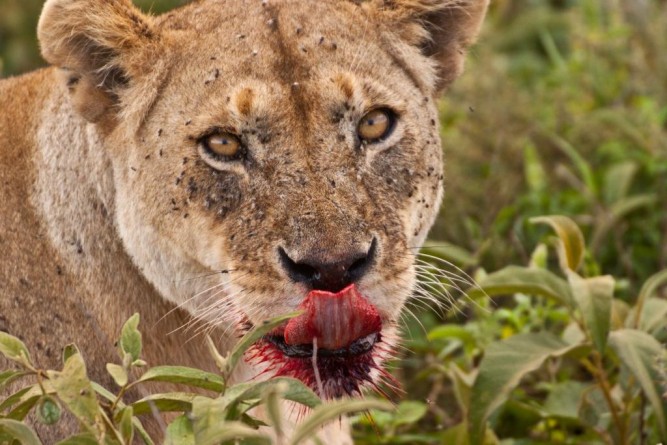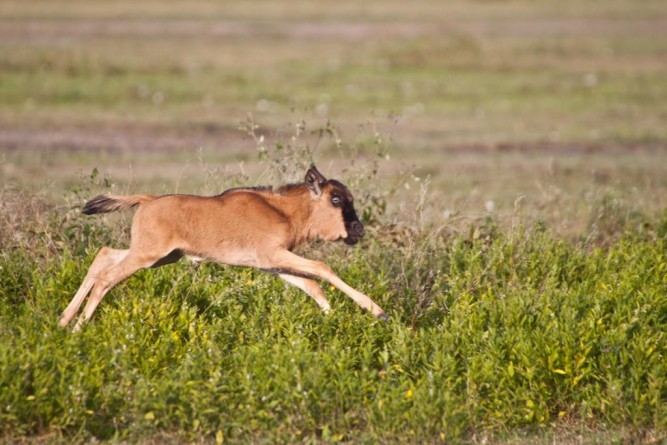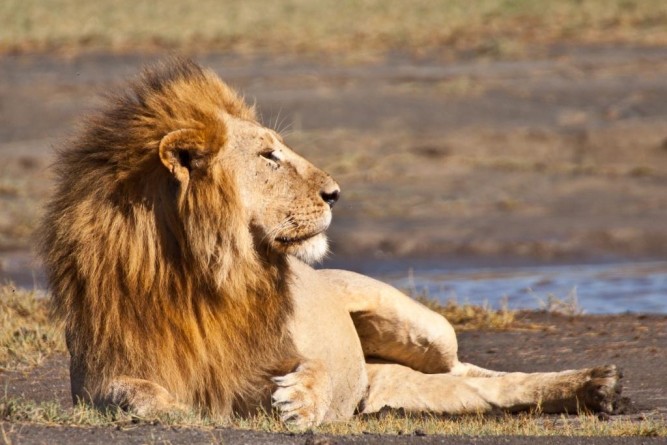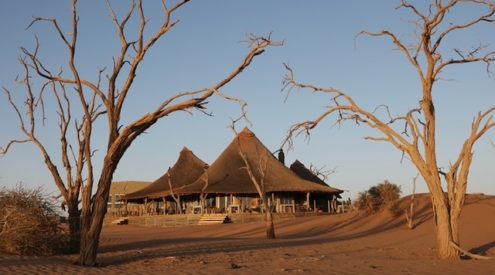If truth be told, I had never heard of Ndutu previously, so as our self-drive safari, booked with Safari Drive, arrived into the area I had no expectations. Driving north west from the Ngorongoro Crater, we journeyed on one of the worst type of roads; highly corrugated, covered in loose gravel and with a steep camber, the going was slow as the vehicle had neither traction nor brakes. However, the vast plains opening up around us were more than enough to take the mind of imminent death.
Turning west on a more bearable track , the skies ahead of us were becoming very dark indeed. Crossing the flat plain, huge dust devils springing up around us, we encountered a few dozen wildebeest and zebra. Their numbers soon became hundreds, then thousands, then tens of thousands. We were catching up with the migration on their annual trek. At this time of year they are heading west and are enjoying the rains around Ndutu. On the side of the road, we came across a large hyena den – out of each of many holes appeared the hyena, with their young.
A little further,we came to the tree line that exists around Lake Ndutu in the far north west of the Ngorongoro Crater Conservation Area and our home for the next two nights at Ang’ata Camp. The skies continued to darken and the trees shone in the last sunlight against the deep blue background. As the clouds descended and turned grey the wind picked up and then; bang! More bangs followed. Half centimetre diameter hail started to rain down on us with increasing ferocity. Ten minutes or so later, the hail turned to torrential rain. Thunder boomed and lightning flashed constantly, all night, without break. Mother Nature was putting on an astounding and non-stop, display. The amount of mud was extraordinary and I had to feel sorry for the staff as guests slipped their way to dinner, only to deposit huge amounts of black mud on the wooden floor of the dining tent.
Next morning and the thunder was starting to die down, but the whole of Ndutu was now thick with black, clay mud that was simply a nightmare to drive on. Nevertheless,we ventured out into the dark as the sun struggled to break through the dispersing cloud. As we (barely) crossed a ‘dry’ river bed, our first sighting of the day was of a family of bat-eared foxes out sifting through the mud looking for insects. They would run around, their tails flicking in the cool, moist air before stopping and fiercely digging up a potential meal.
Several (big) skids later (really, the driving conditions were a nightmare), we came across a clan of hyena, some jackal and two species of vulture squabbling over a kill. The vultures would hang back before sidling up to the carcass, only to be chased off by the hyena.
Then something I had never seen before; I spotted a black-backed jackal stalking a wildebeest calf. All of a sudden, the chase was on and the calf sped off at high speed with the jackal in hot pursuit. For several minutes the pair would loop around us, dodge, jink and speed off in another direction. Eventually the calf spotted its mother and ran as fast as it could in her direction. When it approached the jackal realised the game was up as mum took a step towards the hunter. It backed off and trudged off to find food elsewhere. On our return to camp, we saw a confused baby wildebeest that had decided that a ranger’s vehicle was its mum. It followed around until the vehicle sped off. It tried to keep up but failed. There was an utterly heart-breaking moment when the calf stopped, looked after the vehicle and called. I wanted to cry right there and then. The calf would approach other wildebeest, only to be rebuffed. We left with a serious dampener on our morning that was caused by more than the atrocious road conditions and soggy mud everywhere.
In the afternoon, we decided to venture out to the small marsh (which might sound insane given the state of the roads) but we were rewarded for our efforts by a small pride of lions on a kill.
One was still feeding whilst the rest, covered in flies, lay about in the short vegetation. On our return, we discovered the lost wildebeest calf from earlier in the day had died by the side of a road. But there were still many, many others that were full of life. Its baby season in Ndutu and the young of every animal were all over the place. We enjoyed watching a herd of wildebeest for a while, their young charged around the place getting used to how legs work. Their elbows and knees seem to occupy the same space at any given time, which makes for some serious ungainly movements. One reached around to scratch its back and promptly fell over in the effort. Another bent forward to nibble some grass only to topple over onto its own nose before collapsing into a heap. Hilarious.
Our second morning at Ndutu was clear but chilly; with a beautiful sun rise glowing over the lake. Few signs of the tumult of the last day remained and so we made good progress on our drive. The bat-eared foxes were out again in the morning light, and a little frisky in the coolness. We would watch as they dug up tasty morsels before chasing each other in circles, their bushy tails held high. We headed to the big marsh, and promptly got stuck. The skies may have been clear, and most roads dry, but they don’t call this a marsh for nothing, and our wheels stuck tight in the water-logged mud. After a bit of ingenuity and a lot of mud on clothes, shoes and everywhere else, the vehicle was freed and we returned to the firmer ground around the dry bed of Lake Elemeti. And it’s a good job we did, because a brief chat with one of the guides operating that area gave us the locations of three, increasingly good sightings.
Our first sighting following a precarious crossing of a water-filled ditch in the middle of the dry lake, was of some lionesses sleeping soundly in the sun. Only one looked up at any point whilst another rolled over on her back for a moment. Having a lot of experience of lion behaviour we decided that the best action was not to be found here and we moved on.
Stop two was with a large male lion, his mane blowing gently in the breeze and shining in the morning light. He seemed restless and several times moved off in one direction only to return and head off in another. Part of this indecision is certainly down to the many cars that were maintaining a very close distance to the lion and cutting off his movement whenever he tried to walk away by getting in front of him for the best photo opportunity. We felt that the vehicles were harassing him – part of the problem of allowing vehicles off road as is permitted here, and so again we took a few snaps and moved on.
The last of the three sightings promised to be the most interesting, and it most certainly was. We had heard of five, yes five, cheetah and presumed it was a mother and four cubs. Soon enough, in a clearing, we discovered the cats. Indeed it was a mother with four older cubs – the long fur on their necks nearly all gone. It was getting late in the morning, and we were not expecting too much activity; but we were very wrong. Without warning the cubs started playing. They climbed trees, ran around, jumped on each other, picked up stones and sticks to play with and grappled each other – and all at the fast pace you would expect from the fastest land mammal. Our cameras were barely able to keep up with the chasing cats. At several points, they would hide under the vehicles or sit by the windows so close that you could (but didn’t) reach out and scratch them on the head. Mum joined in at times and the whole experience was simply magical, well up there in the list of my best animal sightings ever. The cubs were just like any domestic cat in their play and I recognized many of the same moves in my two moggies at home. This included their discovery of a camera lens hood dropped by one tourist. For a moment, one cub was fascinated by it,but as with any young cat its attention was soon diverted and the camera part recovered.
After forty minutes or so, the mother decided enough was enough and the family moved off into thicker scrub. We headed back to camp, packed and started our journey north and out of the Ngorongoro Crater Conservation Area. But the NCCA had one last surprise for us. As we left the trees of Ndutu and headed onto the vast plains, we were greeted by countless zebra, wildebeest and gazelle as far as the eye could see in every direction. Never before have I witnessed so many animals in one place, and the experience was more breath taking than I had ever imagined despite David Attenborough’s best attempts over the years to capture the migration in film.
Looking for accomodation in Tanzania? Check out Getaway Accomodation.









